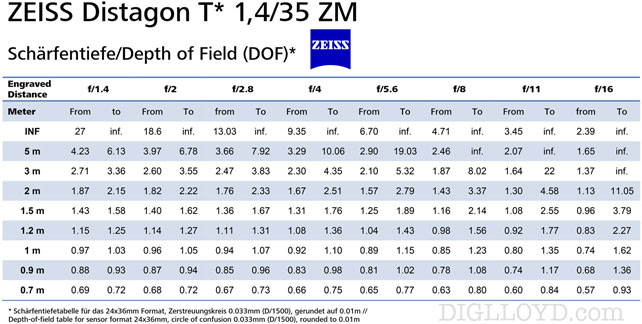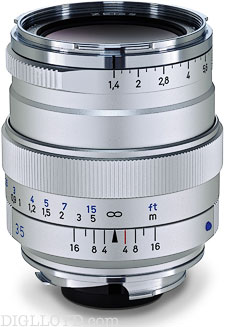EXCERPT page containing first few paragraphs. 2024-04-18 07:53:25
UA_SEARCH_BOT_null @ 3.144.116.159
For full access, subscribe here. Or click title to login. ![]()
Depth of Field Table for Zeiss ZM 35/1.4 Distagon
A depth of field table using 33 microns as the circle of confusion is a debatable choice in the era of high resolution digital. Sometimes conventions should be dropped, changed: as of 2014 hardly anyone shoots film and 33 microns is a huge blur circle visible even in a modest size print as not sharp.
A pixel on a 36-megapixel full frame sensor is less than 5 X 5 microns square, making the “acceptably sharp” CoC about 25 times larger in area than the photosite/pixel, e.g. equivalent to ~1.4 megapixels, quite a far cry from 36 megapixels. The equation is only slightly better for a 24 megapixel sensor.
- 5 X 5 approximate dimensions of the photosite on 36MP full-frame sensor = 25 square microns with diameter ~7 microns.
- 33 microns is the diameter of a theoretical circle of confusion (CoC) having area of π * (33/2)^2 = 855 square microns.
- Hence relative diameter is 33/7 = 4.7X larger than photosite.
Article continues for subscribers...
Diglloyd Guide to Leica is by yearly subscription. Subscribe now for about 25 cents a day ($90/year).
BEST DEAL: get full access to ALL 8 PUBLICATIONS for about 75 cents a day!
Diglloyd Guide to LEICA contains in-depth coverage of Leica M system cameras and lenses, with additional coverage of Leica M Monochrom, Leica Q.
Special emphasis is placed on Leica M lenses and certain Zeiss ZM lenses.
- Make better images by learning how to get the best results right away.
- Save money by choosing the right lens for your needs the first time, particularly the Summilux/Summicron/Elmarit choice and/or Zeiss ZM.
- Make better images, a sort of “cheat sheet” saving yourself months or years of ad-hoc learning. Processing parameters are discussed and shown.
- Jaw-dropping image quality found nowhere else utilizing Retina-grade images up to full camera resolution, plus large crops [past 2 years or so].
- Real world examples with insights found nowhere else. Make sharper images just by understanding lens behavior you won’t read about elsewhere.
- Aperture series from wide open through stopped down, showing the full range of lens performance and bokeh.
- Optical quality analysis of field curvature, focus shift, sharpness, flare, distortion, and performance in the field.
Want a preview? Click on any page below to see an excerpt as well as extensive blog coverage, for example on Leica.



